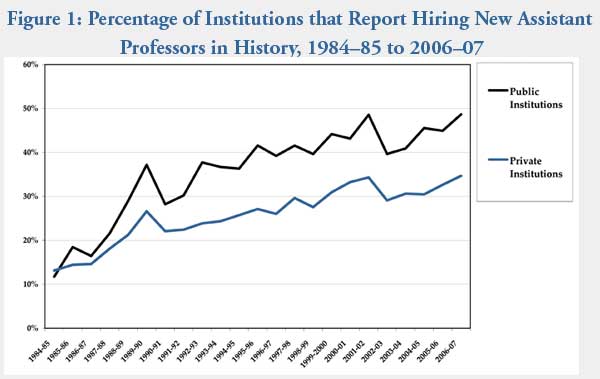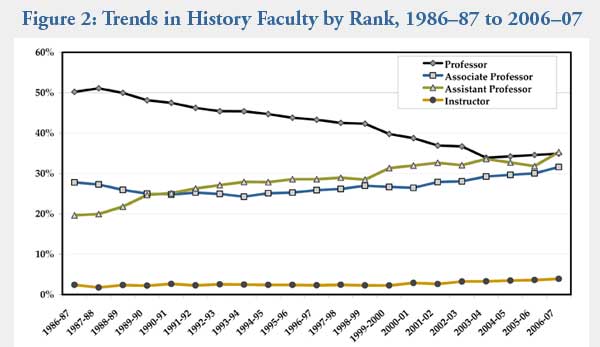The average salary for historians in academia lags well behind that of other disciplines, even when the health sciences are excluded. The average salary for historians at all ranks was $59,619—almost 8 percent below the average reported for all fields of $64,743.
According to the College and University Personnel Association–Human Resources (CUPA–HR), there was only a small gap between the average salaries for historians at private and public colleges and universities. Historians at private institutions earned an average of $60,341, as compared to $58,861 for history faculty at public colleges and universities (Table 1).1
Table 1: Salaries for Historians and Faculty in All Disciplines except the Health Sciences, 2006–07
| Institution Type | Field | Professor | Associate Prof. | Assistant Prof. | New Assistant Prof. | Instructor | All Ranks |
|---|---|---|---|---|---|---|---|
| Private Institutions | History | $74,893 | $58,404 | $48,219 | $47,145 | $39,048 | $59,619 |
| All Fields | $79,504 | $63,250 | $53,317 | $52,948 | $43,734 | $63,534 | |
| Public Institutions | History | $77,397 | $57,987 | $47,741 | $47,084 | $37,756 | $58,861 |
| All Fields | $84,395 | $65,879 | $56,430 | $56,069 | $42,251 | $65,684 |
Unfortunately CUPA–HR re-based their survey data this year, so we cannot track the year-to-year trend in salaries for the discipline. But this report still allows us to compare history to other disciplines at public and private institutions.
As reported in recent years, the largest gap between history salaries and the rest of academia occurs at the bottom rungs of the profession. The average salaries for new assistant professors (those hired to the rank in the fall 2006 term) fell 14.2 percent below the average for the other disciplines. In history assistant professors earned $47,145; in all other fields except the health sciences they earned $54,956.
This gap in average entry-level salaries only emerged about 15 years ago, just as the academic job market turned sour for history PhDs. As the new entry-level assistant professors of 15 years ago were promoted into higher-level positions, average salaries for the field fell below the average for all fields about a decade ago and have continued to decline.
At the top ranks of the field, salaries for full professors lagged 7.5 percent below the average for all disciplines, as historians earned an average of $76,049 compared to the average of $82,220 for all disciplines.
The CUPA–HR data suggest that history salaries are now veering toward salary levels comparable to other humanities disciplines. At the associate and assistant professor level, history salaries fare slightly better than salaries in English Language and Literature and the Visual and Performing Arts; however, at this level, the history salaries are low enough to qualify for CUPA-HR’s list of “Disciplines with the Lowest Average Salaries.” History manages to escape the ignominy of this classification at the full professor level, even as it beats the average professorial salary in English (of $56,786) with about a 5 percent advantage. It is, however, an entirely different story at the entry level, and one that does not perhaps portend well for history salaries in the future: the average salary for a new assistant professor in history was $212 less than the $47,357 that new assistant professors in English received in 2006–07 (that is, starting assistant professors as distinct from assistant professors who had been working for a while, and who are counted separately in the CUPA–HR analysis).
If the comparison between history and the disciplines of the humanities is not disturbing enough, the relationship to salaries in the social science disciplines is even more troubling. The average salary for faculty in the social sciences is $64,435—7.5 percent higher than history. When I first started writing about the salary surveys about a dozen years ago, history could be compared favorably to the other social sciences; but we fell behind them in 1997–98 and have been losing ground ever since.

Figure 1
Within the discipline itself, average salaries for historians at all ranks were slightly higher at private colleges and universities than at public institutions. However, the gap only appeared at the lower and middle ranks (Table 1). The average salaries for full professors were 2.5 percent higher at public institutions.
Beyond the broad averages, the report indicates a sharp difference between the top and bottom levels of the profession. The lowest-paid history instructor earned just about one-eighth the salary of the highest- paid professor in the discipline—though this is narrower than in recent reports, when the highest salary was almost 12 times the lowest.
The salary of the highest-paid history professor at a public university was $192,360, as compared to $18,000 for the lowest-paid lecturer. At private institutions the difference was slightly smaller: the salary of a professor at the top rank was $197,000, as compared to $28,265 for the lowest-paid faculty member.
Signs of Improvement in Junior Hirings
Since the CUPA-HR report separates out the new hires from the rest of the faculty, we can also look at the data for information on the state of the job market. And the news on that score is much more positive than the salary data, as more than a third of the 695 reporting departments indicated hiring at least one new assistant professor for the fall 2006 term.
Public colleges and universities led the way, as 48.6 percent of the departments in the survey reported hiring at least one new assistant professor (Figure 1). In all, 144 of the 296 public institutions reported hiring 222 new assistant professors.

Figure 2
In comparison, only a quarter of the private colleges and universities reported a new hire last year, as 97 of the 399 private institutions reported hiring 120 new assistant professors. But because private colleges and universities have much smaller departments on average, these figures are in line with past trends (and were exceeded only in the 2000–01 academic year).
The CUPA–HR data thus indicate continued growth in the number of full-time faculty employed by departments, but within that growth there is a marked transformation in the composition of the departments. Twenty years ago CUPA–HR singled out history departments as tending to be unusually top-heavy with more faculty at full professor rank. But this past year the proportion of assistant professors exceeded the proportion of full professors in history departments for the first time since CUPA–HR started tracking this information (Figure 2). This may be a mixed blessing. While new job opportunities for junior faculty may open up, the loss in the proportion of senior faculty may reduce the number of faculty in a position to advocate equitable salaries for the discipline.
Note
- CUPA–HR, National Faculty Salary Survey by Discipline and Rank in Four-Year Colleges and Universities for the 2006–07 Academic Year (Washington, D.C.: CUPA–HR, 2007). Salary figures are based on a nine- or ten-month academic year, full-time faculty only. Fringe benefits and summer earnings are excluded. Copies can be obtained from CUPA–HR at 1233 20th St. NW, Ste. 301, Washington, DC 20036-1250 or through the web site at www.cupahr.org/. [↩]

